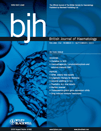GIMEMA AIDA 0493 amended protocol for elderly patients with acute promyelocytic leukaemia. Long-term results and prognostic factors
Summary
To reduce toxicity in elderly patients with acute promyelocytic leukaemia, in 1997 the Gruppo Italiano Malattie Ematologiche Dell’Adulto (GIMEMA) started an amended protocol for patients aged >60 years, with the same induction [all-trans retinoic acid (ATRA) + idarubicin] as in younger patients, followed by a single consolidation course (idarubicin + cytarabine) and maintenance with intermittent ATRA. Among 60 enrolled patients, 54 (90%) achieved haematological remission and six died during induction. Four additional patients died in complete remission (CR) from haemorrhage (2) and infection (2) prior or during consolidation therapy. Eleven patients relapsed at a median time of 17·5 months from CR. The 5-year overall survival (OS), disease-free survival (DFS) and cumulative incidence of relapse (CIR) rates were 76·1%, 64·6% and 27·4%, respectively. Univariate analysis identified a performance score (PS) = 2 as the only significant adverse prognostic factor for both OS (P = 0·017) and DFS (P = 0·0003). Male sex had an unfavourable impact on DFS (P = 0·021) and on CIR (P = 0·019), but not on OS (P = 0·234). In multivariate analysis for DFS, only PS = 2 retained prognostic significance (HR = 4·5, P = 0·0083). In conclusion, the amended GIMEMA protocol is effective, with similar relapse rate and inferior toxicity compared to the original AIDA 0493. However, considering the recent availability of effective new agents, a less aggressive approach should be tested in this setting.




